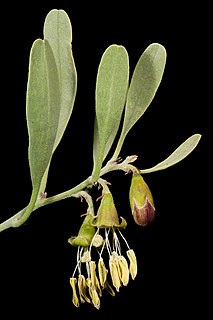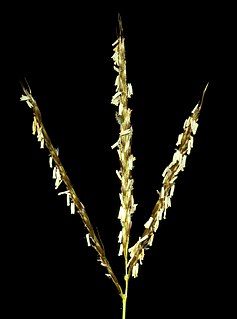
Menispermum (moonseed) is a small genus of deciduous climbing woody vines in the moonseed family (Menispermaceae). Plants in this genus have small dioecious flowers, and clusters of small grape-like drupes. The name, moonseed, comes from the shape of the seed, which resembles a crescent moon. The word Menispermum is derived from the Greek words μήν (mēn), meaning moon, and σπέρμα (sperma) meaning seed. The common name moonseed is also applied to some other species in the related genus Cocculus.

Solanum centrale, the kutjera, or Australian desert raisin, is a plant native to the more arid parts of Australia. Like other "bush tomatoes", it has been used as a food source by Central Australia and Aboriginal groups for millennia.

Menispermaceae is a family of flowering plants. The alkaloid tubocurarine, a neuromuscular blocker and the active ingredient in the 'tube curare' form of the dart poison curare, is derived from the South American liana Chondrodendron tomentosum. Several other South American genera belonging to the family have been used to prepare the 'pot' and calabash' forms of curare. The family contains 68 genera with some 440 species, which are distributed throughout low-lying tropical areas with some species present in temperate and arid regions.

Marsdenia australis, commonly known as the bush banana, silky pear or green vine is an Australian native plant. It is found in Central Australia and throughout Western Australia. It is a bush tucker food used by Indigenous Australians.

Ventilago viminalis, commonly known as supplejack, vine tree or whip vine, is a tree native to Northern and Central Australia from coastal regions of Queensland to the Northern Territory and Western Australia.

Tinospora cordifolia is a herbaceous vine of the family Menispermaceae indigenous to tropical regions of the Indian subcontinent. It has been in use for centuries in traditional medicine to treat various disorders.

Eudocima materna, the dot-underwing moth, is a moth of the family Erebidae found in widespread parts of the world, mainly in tropical Asia extending to New Guinea and Australia as well as in Africa. Reports from the United States, Canada and the French Antilles are now considered to be Eudocima apta. The species can be differentiated from other Eudocima moths by the presence of small central black dot in each hindwing. The species was first described by Carl Linnaeus in his 1767 12th edition of Systema Naturae.

Tecticornia indica is a species of plant that is succulent and halophyte which grows in salt marshes on tropical areas of the world. This plant belongs to the Chenopodiaceae, which are now included in family Amaranthaceae.
Lewis Leonard Forman was a British botanist, born in London. He was an expert on spermatophytes, particularly Menispermaceae, and specialised in the plants of Southeast Asia. He graduated from the University of London in 1950 and was appointed to the staff of the Royal Botanic Gardens, Kew in 1951, serving as a senior official there from 1966 to 1989.

Sclerolaena bicornis, commonly known as goathead burr, is a perennial shrub in the Amaranthaceae family, native to inland Australia, and found in Queensland, the Northern Territory, South Australia, New South Wales, and Western Australia

Tinospora is a genus of succulent woody climbing shrubs. Thirty-four species are currently recognized. Species generally send down long aerial roots from host trees. They have corky or papery bark. They are found in tropical and sub-tropical parts of Asia, Africa and Australia. The most common species are T. cordifolia and T. crispa.

Stylobasium spathulatum is a species of xerophytic shrub in the family Surianaceae. It was first described in 1819 by René Louiche Desfontaines and is endemic to the Northern Territory, Queensland, and Western Australia.
Calotis pubescens is a species of daisy endemic to Australia and found in New South Wales and Victoria.

Austrostipa hemipogon is a tufted, perennial grass (a member of the Poaceae family. It is native to Australia, and found in Western Australia, South Australia, Victoria, and Tasmania.

Eulalia aurea is a grass. It was first described as Andropogon aureum in 1804 by Bory de Saint-Vincent but was transferred to the genus, Eulalia, in 1830 by Kunth.

Tecticornia verrrucosa is a species of plant that is succulent and halophyte. This plant was a member of the Chenopodiaceae, which are now included in family Amaranthaceae.
Alternanthera angustifolia is a small herb in family Amaranthaceae found widely in inland Australia from northern Western Australia, the Northern Territory, South Australia, New South Wales to Queensland.
Blumea tenella is a daisy found in northern Australia from Queensland through the Northern Territory to Western Australia. It is also found in Indonesia, Borneo, New Guinea and New Caledonia.
Glenn Mitchell Wightman is an ethnobotanist working for the Department of Environment Parks and Water Security, in Palmerston. He works closely with various language groups to document plant and animal names and their usage in the culture. In doing so, he has been helping to preserve some 48 Aboriginal languages in collaboration with some 252 Indigenous co-authors. He has also done biocultural work in Indonesia.

Macgregoria racemigera is a small plant in the family Celastraceae) found in inland Australia from New South Wales through Queensland, the Northern Territory to Western Australia, and South Australia.














